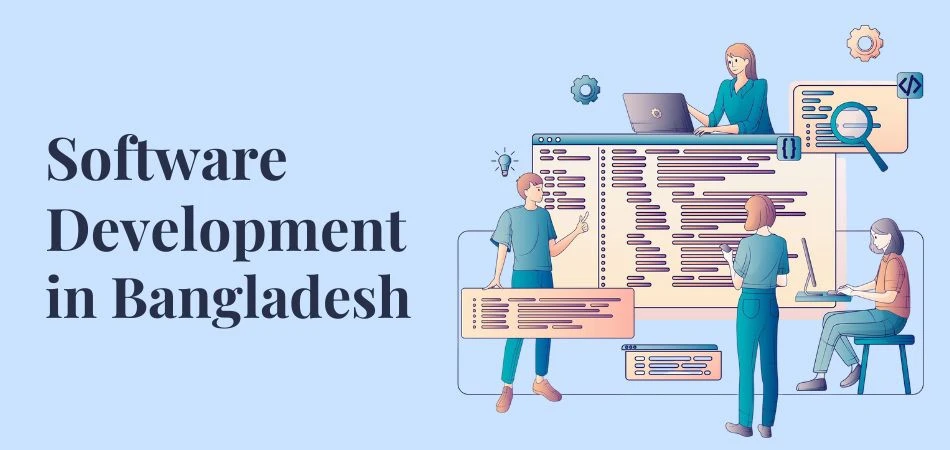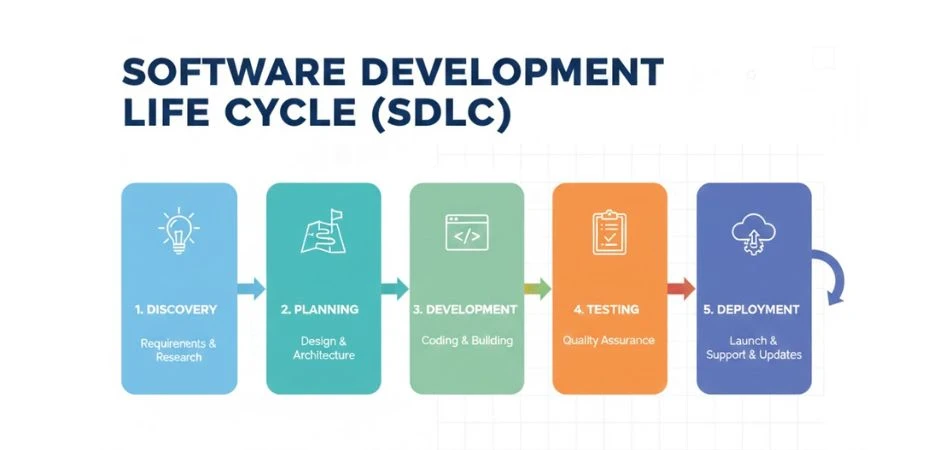Businesses move money in and out every single day, customers make payments, and companies
The POS & Inventory Management System is an all-in-one business solution designed
HR & Payroll Software is designed to simplify workforce management by automating
ERP (Enterprise Resource Planning) software in Bangladesh is becoming essential
Managing business finances is no longer a headache when you use accounting software.
An Inventory Management System (IMS) helps businesses in Bangladesh track, manage,
POS (Point of Sale) software is an all-in-one solution for businesses to manage sales,
The Hotel Reservation and Booking System is a modern solution designed to help hotels
Bangladesh’s IT industry is witnessing a rapid transformation. With increasing digitization, businesses across sectors are investing heavily in software solutions to gain efficiency, agility and competitive edge. Software development services in Bangladesh are no longer confined to basic web design or small local apps; instead they encompass rich, enterprise-grade solutions that support industries such as healthcare, finance, education, e-commerce, manufacturing and beyond.

Software development is the process of designing, creating, testing, and maintaining software applications or systems. It is a crucial part of modern technology, powering everything from mobile apps and desktop software to enterprise solutions and web applications. Effective software development enables businesses, organizations, and individuals to automate processes, improve productivity, and create innovative solutions.
The importance of software development cannot be overstated: it powers digital transformation, enables automation of business processes, supports global expansion and allows organisations to adapt to evolving market demands. In Bangladesh, an emerging ecosystem of software companies, freelancers and allied services is helping domestic and international clients achieve these goals.
Industries benefiting include:
Together, these underline why selecting a reliable software development service in Bangladesh can be a strategic asset for any organisation.
Software development companies in Bangladesh provide a wide range of services designed to address the unique needs of businesses, whether they are startups, SMEs, or large enterprises. Key offerings include:
These offerings reflect the diverse requirements of modern businesses from startups needing a lightweight mobile MVP to large enterprises seeking full-scale ERP or CRM solutions. By providing tailored and scalable services, Bangladeshi software companies help businesses innovate, grow, and compete globally.
The Software Development Lifecycle (SDLC) provides a structured framework for planning, creating, deploying, and maintaining software. Below is a detailed explanation of each stage:

In this phase, projects are envisioned, requirements are gathered, and objectives are clearly defined to establish a strong foundation for development. Teams conduct product research, perform feasibility studies, and create initial designs. Agile methodologies guide iterative planning, while DevOps principles provide best practices for development and operations. Tools like Confluence are often used to document research, share design files, and collaborate effectively with stakeholders.
During the planning phase, project concepts are transformed into actionable tasks, resources are allocated, and timelines are established to ensure smooth execution. Stakeholders are identified, budgets are set, and infrastructure is requisitioned. Detailed design documents from the discovery stage are broken down into specific tasks, and project roadmaps are developed to track progress. Task management tools such as Jira and Trello help teams organize and monitor work efficiently throughout the project.
The build and test phase involves developing production-ready software while ensuring it meets all functional, performance, and quality requirements. Developers write clean and efficient code, and designers implement user-friendly interfaces. Testing is conducted at multiple levels, including unit testing, integration testing, and system testing, to validate the software’s performance and security. Continuous Integration and Continuous Deployment (CI/CD) pipelines streamline the workflow, and platforms like Bitbucket enable collaborative code review and automated testing.
In the deployment phase, the tested and approved software is released into a live production environment. Code is merged, configured, and deployed, ensuring the system is fully operational for end-users. Cloud hosting platforms such as Amazon AWS, Google Cloud Platform, and Microsoft Azure are commonly used to provide reliable infrastructure. CI/CD pipelines further simplify the deployment process, allowing teams to deliver updates quickly and efficiently.
Once deployed, the software enters the operations phase, where day-to-day functioning, maintenance, and support are provided. Teams monitor system performance, address user issues, implement minor enhancements, and perform regular backups. Efficient operation ensures software remains stable, reliable, and user-friendly over time. Tools like Jira Service Management help capture, triage, and resolve support requests effectively.
The observation phase focuses on monitoring software performance, collecting user feedback, and managing incidents to drive continuous improvement. Any unplanned events or service disruptions are prioritized and resolved promptly to minimize impact. Analytics and performance monitoring provide insights into system usage, guiding future iterations and updates to enhance functionality, efficiency, and user satisfaction.
Different types of development approaches or methodologies serve different project contexts. Key ones include:
Selecting the right approach depends on project size, complexity, clarity of requirements, stakeholder preferences and risk tolerance.
A successful software project draws on multiple roles, each with distinct responsibilities:
Clear definition and coordination of these roles help avoid duplication, gaps or misalignment, ensuring the software project delivers on business goals.
Successful software development relies on following proven best practices. Key practices include maintaining clean, well-documented code, using version control (e.g., Git) for collaboration and traceability, and performing code reviews and automated testing to ensure quality and reliability. Implementing CI/CD pipelines enables rapid and safe deployment, while integrating security and compliance throughout the lifecycle protects data and meets regulatory standards. Clear communication and transparent project management keep teams aligned, and designing for scalability and maintainability ensures the software can grow and adapt over time. Adhering to these practices minimizes risks, reduces delays, and improves overall project success.
Bangladesh is rapidly establishing itself as a global hub for software development, home to over 4,500 software and ICT companies and a skilled workforce of more than 300,000 professionals. The nation’s technology sector continues to expand, fueled by strong domestic innovation and growing international demand.
These advancements highlight Bangladesh’s growing reputation as a competitive, technology-driven destination for global software development and digital transformation services.
Best Software Companies In Bangladesh

A modern software development partner in Bangladesh typically uses a mix of technologies. Some frequently used ones:
| Category | Popular Technologies & Tools | Description / Use Case |
|---|---|---|
| Programming Languages | Java, Python, PHP, JavaScript (Node.js) | Core languages for backend and full-stack development, enabling scalable and efficient software solutions. |
| Frameworks | React, Angular, Django, Laravel | Used for building dynamic web applications with speed, structure, and maintainability. |
| Databases | MySQL, PostgreSQL, MongoDB | Manage, store, and retrieve structured or unstructured data efficiently for various applications. |
| Mobile Development | Flutter, React Native, Swift (iOS), Kotlin (Android) | Frameworks and languages for developing high-performance native and cross-platform mobile apps. |
| Cloud Platforms | AWS, Microsoft Azure, Google Cloud | Provide scalable infrastructure, hosting, storage, and deployment environments for modern applications. |
| DevOps Tools | Docker, Kubernetes, Jenkins, GitLab CI/CD | Automate build, testing, and deployment processes to improve collaboration and speed in development cycles. |
Selecting a partner familiar with the relevant technology stack for your project ensures faster delivery, better maintainability and smoother integration with your systems.
Selecting the right software development partner in Bangladesh, or anywhere in the world, can define the success of your digital initiative. Beyond pricing, the best partnerships are built on expertise, transparency, and long-term reliability. Here are the key factors to evaluate before making your decision.
Choose a company with a strong track record in your specific industry or project type. Review their past projects, client base, and case studies to assess their ability to deliver complex, scalable, and results-driven software solutions.
Ensure the development team is skilled in modern and relevant technologies such as cloud, mobile, DevOps, and AI. Certified developers and ongoing technical training reflect a company’s commitment to innovation and quality.
Reputation speaks volumes. Look for genuine client testimonials, references, and measurable success stories that highlight their reliability, problem-solving approach, and customer satisfaction.
Transparent and proactive communication is vital. Evaluate how the company manages collaboration, including progress tracking, milestone reporting, and issue resolution. Tools like Jira, Trello, or Slack are good indicators of a mature project management process.
While competitive pricing is important, value should always outweigh cost. Assess the total service package, including maintenance, scalability, SLA terms, and the availability of ongoing technical support after launch.
A quality-driven partner integrates automated testing, continuous integration, and deployment (CI/CD) into their workflow to ensure consistent performance, reduced bugs, and faster releases.
Check whether the partner follows data protection, privacy regulations, and disaster recovery protocols. Security should be built into every stage of development, not treated as an afterthought.
For global collaborations, cultural alignment and communication style are important. Bangladesh offers an excellent balance with cost-effective development, strong English proficiency, and convenient time-zone overlap with Western and Asian markets.
By carefully evaluating these factors, you can choose a software development partner in Bangladesh who not only meets your technical needs but also aligns with your strategic goals, budget, and long-term vision, turning your ideas into reliable and scalable digital solutions.
In a rapidly digitising world, software development services in Bangladesh present a strong value proposition combining cost-effectiveness, talent availability, growing infrastructure and proven delivery capabilities. For businesses seeking custom software, mobile apps, web solutions, ERP/CRM systems or e-commerce platforms, partnering with a competent Bangladeshi provider can yield meaningful business impact.
By following structured methods (SDLC), selecting the right approach (Agile, DevOps), recognising the key roles, adhering to best practices and harnessing automation, you can achieve high-quality software outcomes. Coupled with careful partner selection, attention to infrastructure and process alignment, your organisation can leverage Bangladesh’s emerging software ecosystem with confidence.